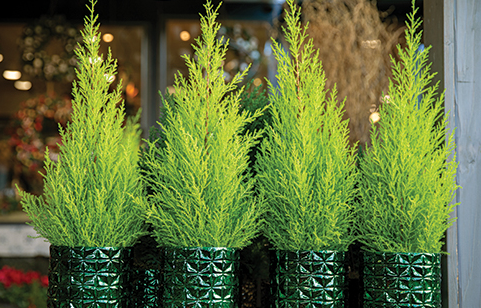
The Lemon Cypress, scientifically referred to as Cupressus macrocarpa ‘Goldcrest’ or commonly also known as Golden Cypress or Italian Stone is believed to have originated from a mutation or selective breeding of the Monterey cypress. It was introduced as a cultivated plant for landscaping and container gardening because of its compact size, unique coloration, and pleasant fragrance.
Lemon cypress trees have yellow-green foliage that emits a fresh, lemon-like scent when the foliage is brushed or crushed. They have a pyramidal or columnar growth habit and reach a height of 6-8 feet when planted in the ground. Their foliage consists of scale-like leaves arranged in flattened sprays. The branches grow upward.
The lemon cypress tree was first introduced to Europe in the early 19th century and brought to the United States in the late 19th century. The tree later became popular in the United States, Europe, New Zealand, and Australia. Information points to its development sometime in the late 20th century. Experts like John Greenlee played a role in its distribution, but the exact origin seems to be undocumented
Lemon Cypress can be grown outdoors in areas with mild winters (0°F to 30°F (-18°C to -1°C). In united states these would be areas along the West Coast, the Southwest, and the Southeast. In many places these cypress is commonly grown as a potted plant. Some people use it for holiday decorations, particularly during the winter season as a living Christmas tree alternative or as part of festive arrangements.
Cultural Characteristics of Lemon Cypress
- It grows to a height of 6 to 10 feet (1.8 to 3 meters) when planted in the ground. In containers, it remains smaller, often around 2 to 4 feet (0.6 to 1.2 meters) tall.
- It consists of feathery, needle-like leaves that are bright yellow-green in color. The scale-like leaves emits a fresh, lemon-like scent when brushed or crushed against.
- It grows steadily but not excessively fast. It gains around 6 to 12 inches (15 to 30 centimeters) of height per year.
- The bark is reddish-brown in color and becomes rough and furrowed with age, similar to the bark of the Monterey cypress.
- It has a relatively shallow root system, spreading out rather than digging deeply into the soil.
- Can live for a few decades if cared for well or not subjected to stressors such as drought or diseases. In the wild it can be up to 150 years.
- It has a columnar or conical shape, with dense branching that forms a compact, narrow silhouette. It maintains its shape well with minimal pruning.
- It thrives in bright, direct sunlight but can tolerate some shade.
- Prefers well-draining soil. It prefers slightly acidic to neutral soil pH and can adapt to various soil types, including sandy, loamy, or clay soils.
- It has moderate water needs. It prefers evenly moist soil but can tolerate short periods of drought once established.
- It is cold hardy and can tolerate temperatures down to USDA Hardiness Zones 7 through 10.
- It is generally resistant to most pests and diseases, but it may be susceptible to certain issues such as spider mites, scale insects, or root rot if conditions are unfavorable.
- Benefits from a slow-release fertilizer applied before new growth appears in spring.
How To Prune Lemon Cypress
The best time to prune your lemon cypress is in late winter or early spring, just before the new growth begins. This timing allows the tree to recover quickly from pruning and encourages new growth in the upcoming season.
Before you start pruning, take a moment to assess the tree’s overall health and structure. Identify any dead, damaged, or diseased branches that need to be removed. Also, look for any branches that are crossing or rubbing against each other, as these can cause damage over time.
Begin by removing any dead, damaged, or diseased branches. Make clean cuts as close to the trunk or main branch as possible without cutting into the branch collar (the swollen area where the branch meets the trunk). This will help the tree heal more quickly and prevent the spread of diseases.
To improve air circulation and sunlight penetration, thin out the tree by selectively removing some of the interior branches. This can help reduce the risk of pests and diseases and promote healthier growth. When thinning, make clean cuts at the base of the branch where it meets a larger branch or the trunk.
If you want to maintain a specific shape or size, use pruning to gently guide the tree’s growth. Make cuts just above a lateral branch or bud that is growing in the desired direction. Avoid cutting back more than one-third of the tree’s foliage at a time, as this can weaken the tree and inhibit its ability to recover.
If you are growing your lemon cypress as a hedge or for topiary, you may need to prune more frequently to maintain the desired shape. In this case, use hedge shears or pruning shears to make precise cuts and maintain a clean, even shape.
After pruning, water the tree thoroughly to help it recover and promote new growth. Monitor the tree for signs of stress or disease, and adjust your care routine as needed.
Cultivars of Monterey cypress similar to Lemon Cypress
| ‘Golden Pillar’ | Golden-yellow foliage |
| ‘Gold Cone’ | Yellow foliage |
| ‘Tiny Tower’ | Greenish yellow |
| ‘Citriodora’ | Bright green coloration foliage |
| ‘Greenstead Magnificent’ | Vibrant yellow-green foliage |
| ‘Wilkman Golden’ | Golden-yellow color |
| ‘Citriodora Aurea’ | Golden-yellow coloration |
| ‘Goldcrest Curls’ | – Curled, twisted foliage |